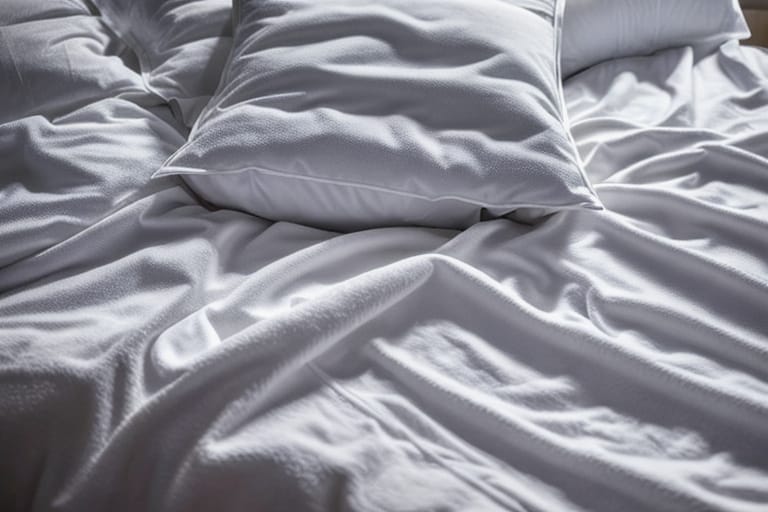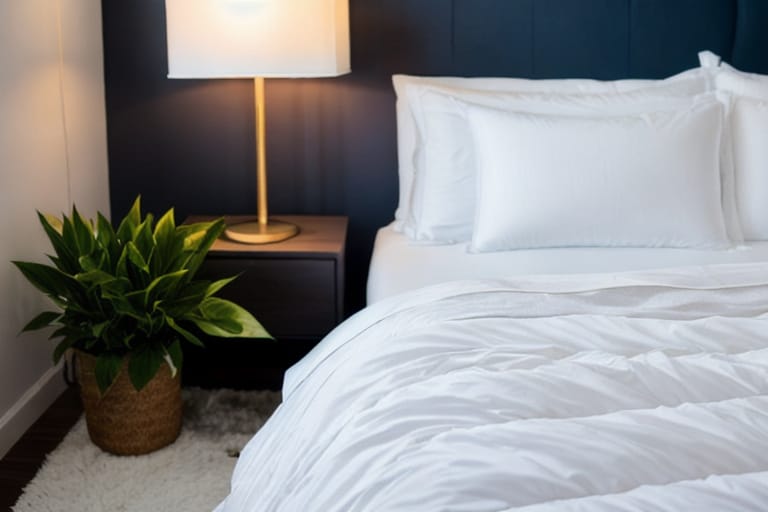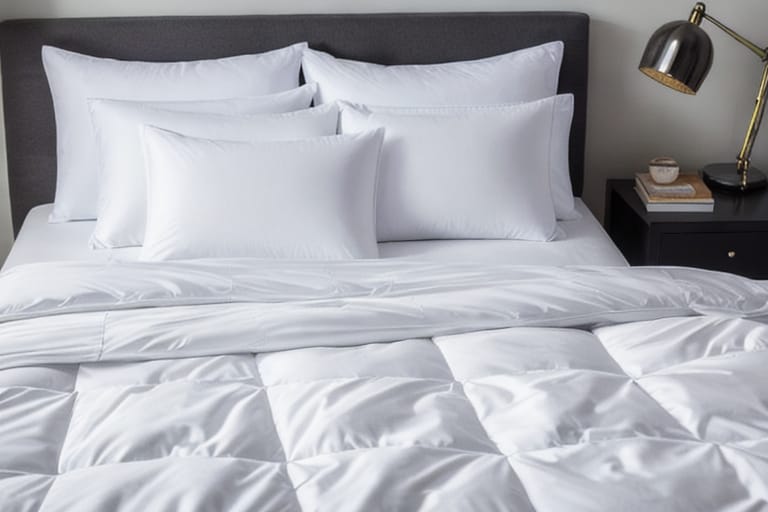Do you cringe when your down comforter makes loud swishing or crinkling sounds every time you roll over in bed? The noisy disturbance preventing you from getting a good night’s sleep? You’re not alone. Many people find their down comforters overly loud when new or with regular use over time. But not all down bedding causes noise disruptions during sleep.
Understanding what makes some down comforters noisier than others requires looking into aspects of construction, materials, maintenance, and use. With this knowledge, you can better evaluate comforter noise levels during the selection process to find optimal quietness for uninterrupted rest.
This beginner’s guide will explore common reasons behind down comforter noise and simple solutions to reduce sounds. Follow our tips to make informed choices towards a peacefully quiet sleeping environment for better sleep satisfaction.
What Factors Influence Down Comforter Noise
Several elements contribute to noise production in down comforters:
Down Filling
The puffy down interior stuffed between the outer shell layers commonly makes subtle rustling sounds with movement. Springs of feather quills and filaments can rub together, emitting soft crunching and crackling noises. Higher percentages of delicate down clusters minimize noise potential compared to firmer, sturdier feathers.
Goose down proves slightly quieter than duck down on average due to more supple filaments. Firmer-stemmed duck feathers produce more friction, especially in cold weather when down contracts. However, with the right construction, both can muffle noise effectively.
Shell Fabric
A down comforter’s outer fabric impacts noise levels significantly. Lightweight cotton shells swish more noticeably compared to smoothly woven cambric cotton or durable batiste fabric.
Downproof fabrics, like batiste, feature exceptionally tight weaves that prevent filling leakage while also inhibiting sound. This barrier buffers comforter movement to prevent inner friction noises escaping outward.
Fill Power
Higher fill power numbers, indicating more lofty, insulating down per ounce, mean larger clusters and pockets of air between quills. Bigger spaces cushion sounds, while dense, compact down compresses to amplify noises.
Most quality comforters range from 600 to 800 fill power as optimal for warmth, softness, and noise reduction.
Stitching and Baffles
Outside fabric attaches to inner walls that section off down into baffles. This quilted design keeps filling evenly distributed while lending structure.
More baffles with tighter stitching prevent shifting clumps that can lead to vacuous air pockets. This stability creates less sound when bearing weight. Sturdy baffles also stop the comforter surface from creasing, which further diminishes noise potential.
Moisture Resistance
Occasional laundering leaves unavoidable residual dampness. Lingering humidity introduces condensation and allows moist down to swell and clump together once fluffed up after drying. This causes crinkly areas lacking loft that produce sharp crackles when compressed.
Higher-end comforters integrate moisture-resistant materials, like durable water repellent (DWR) sprays, or hydrophobic coatings into fabric fibers during construction. These friction-reducing layers keep down smoothly separated.

Signs of a Noisy Down Comforter
You need not resign yourself to another frustrating, sleepless night of crinkly comforter chaos. Helpful indicators during the selection process signal which options run louder than others before purchase. Critically evaluating potential sound qualities ensures ultimate satisfaction.
Stiff, Lightweight Shell Fabric
Thin, stiff fabric lacks the supple drape to move freely and quietly. This causes crinkling whenever you shift position.
Aim for smoothly woven, mid-weight shell material with some natural elasticity for optimal flex and cushion. Softer hand-feels typically equate to better sound absorption.
Low Fill Power
Skimping savings on a budget buy often backfires in poor nighttime noise disruption. Lower fill down, under 500 fill power, packs tightly. The dense mass enlarges surface contact area in each quilted section, amplifying friction reverberations.
Ideally, choose higher quality options in the 600+ fill power range for sufficiently stuffed, silent comfort.
Few Wide Baffles
Wide quilting compartments with sparse stitching strands permits filling to slip and slide together. This generates noisy void patches which compress and rub against taught outer walls.
Seeking designs with narrower baffles retained by dense reinforced stitching prevents sound-creating shifts.
Light Fiber Filling
Feathers, silk, wool, polyester—various down alternative fibers make quieter options compared to pure plumage if noise sensitivity runs high. Without quills, synthetic fills eliminate internal feather friction contact points completely while minimizing exterior swishing sounds.
However, these solid-fiber options don’t offer the heavenly lightweight loft feeling many down enthusiasts enjoy.
Silent, Noise-Free Down Comforter
The most critical comforter features that safeguard soundless nights include:
- Mid-weight batiste cotton or cambric cotton shell fabric, around 230 thread count
- 800+ fill power goose down
- Baffle boxes with reinforced stitching every 6-12 inches
- Downproof fabric with moisture protection layer
- Fill weight between 15-50 ounces for queen sizes
Reviews spotlighting “noiseless” and “silent” in a sea of positive feedback further help indicate suitable choices likeliest to deliver on dreamy, undisturbed comfort.
Best Noiseless Down Comforters
Based on quality construction and unanimous rave reviews praising their ultra-quiet comfort, these three premium options rank as top recommendations guaranteed to minimize disruptive noise issues:
ExceptionalSheets Down Comforter
- 100% cotton cover; 230 thread count
- hydrophobically treated dust mite resistant fabric
- Premium 850 fill power goose down
- Double needle baffle box stitching
- “Zero noise even with movement.”
Royal Hotel’s Down Comforter
- 300 thread count 100% cotton cover
- 750 fill power goose down
- Soft, breathable, noiseless fabric
- “I can’t get over how quiet it is.”
Pacific Coast Feather Cloud Comforter
- 330 thread count cotton sateen fabric
- Medium warmth 550 fill power European white down
- Deep baffle box design prevents shifting
- “Silent, light, warm perfection.”
Thoughtfully constructed with premium materials, these comfortable, silent comforters promise many peaceful nights ahead.

Caring Properly For Quietest Performance
Simple care and maintenance further safeguards your comforter’s noiseless integrity over time:
- Dry thoroughly after washing – prevent moisture pooling inside
- Fluff regularly while drying to redistribute and separate clumped down clusters
- Use duvet cover to prevent body oils from deteriorating fabric’s noise-buffering capacity
- Avoid excessive heat – protect fill power loft by skipping the dryer when drying
With proper use and care, higher quality comforters maintain comfortable quietness for years before needing replacement.
Common Comforter Noise FAQs Answered
Still seeking solutions to address frustrating comforter noise disruptions? These expert answers target quick fixes for common sounding issues:
Q: Why does my comforter make loud crinkling sounds suddenly?
A: Excess condensed moisture likely built up inside, causing dry down to clump and shift. Fully air dry on low heat or hang outside on a breezy day. Regularly fluff clumps while drying. Consider adding a protective waterproof cover if humidity persists.
Q: How do I make an old, noisy comforter quiet again?
A: Unfortunately, little remedies deteriorating sound quality from worn materials and compressed batt insulation. For uninterrupted sleep, the best solution is investing in a new high-fill power comforter designed explicitly for noise reduction.
Q: Why is my comforter loud when I roll over or move in bed?
A: Stiff, light outer fabric adds noise when disturbed. Low fill power also compacts more noticeably with pressure. Opt for medium-weight covers with high loft down for the most silent, undisturbed sleep, no matter how much you toss and turn!
Achieving Blissfully Quiet, Restorative Sleep
The comforting feeling of slipping under a cozy down comforter offers a warm invitation to tranquilly drift off to sleep. That is, until your bedding begins loudly crunching and crackling every time you shift sleeping positions!
But noisy nights fraught with disruptions don’t have to be the norm. By understanding causative factors, evaluating quality indicators, and selecting the optimal construction for your needs, finding that elusive silent comforter gets much easier. Investing a bit more in premium materials makes all the difference in sustained durability too.








